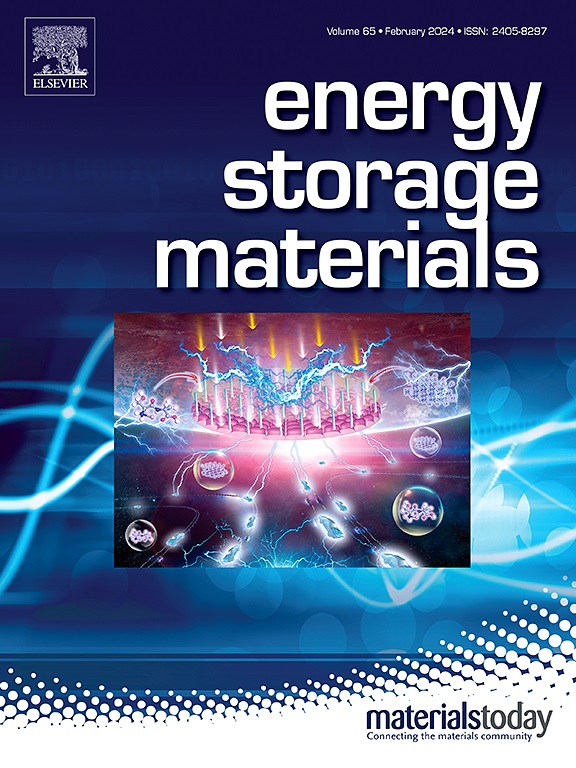Failure mechanism of sulfurized polyacrylonitrile (SPAN) cathode induced by boron-contained lithium salt
IF 18.9
1区 材料科学
Q1 CHEMISTRY, PHYSICAL
引用次数: 0
Abstract
Sulfurized polyacrylonitrile (SPAN) is deemed as the most promising lithium-sulfur (Li-S) batteries cathode owing to high sulfur utilization degree and stable cycling performance. However, abnormal high initial capacity of 2683.2 mA h g-1 and severe degradation (100.5 mA h g-1, 100 cycles) induced by LiDFOB salt are observed in our work. To conduct in-depth research on related mechanism, LiPF6 and LiTFSI based batteries are tested as fair comparisons and relatively cycling performances are exhibited. The electrochemical performance of electrolyte and the interfacial properties of cycled Li anode are compared, then the impact of Li ion transfer and parasitic interface reactions are excluded. Synchrotron-based pair distribution function (PDF) and Raman spectroscopy tests indicate that new B-S bonds are generated on SPAN during the first discharge process in LiDFOB based battery, while the insertion of Li ions on S sites are greatly suppressed. Density functional theory method suggests that active S sites after S-S bond cleavage will be attacked and bonded by B from DFOB-, which is hard to break and continuously inhibit effective reactions between Li ions and S, leading to serious irreversible battery degradation. The failure mechanism of SPAN cathode induced by boron-contained lithium salt are further verified by LiBOB.


含硼锂盐诱导硫化聚丙烯腈(SPAN)阴极失效机理
硫化聚丙烯腈(SPAN)以其高硫利用率和稳定的循环性能被认为是最有前途的锂硫电池正极材料。然而,在我们的研究中,我们观察到LiDFOB盐诱导的异常高初始容量(2683.2 mA h -1)和严重的降解(100.5 mA h -1, 100次循环)。为了深入研究相关机理,对LiPF6和LiTFSI基电池进行了测试,并进行了公平的比较,展示了相对的循环性能。比较了电解液的电化学性能和循环锂阳极的界面性能,排除了锂离子转移和寄生界面反应的影响。基于同步加速器的对分布函数(PDF)和拉曼光谱测试表明,LiDFOB基电池在首次放电过程中在SPAN上产生了新的B-S键,而Li离子在S位点的插入被大大抑制。密度功能理论方法认为,S-S键断裂后的活性S位点会被DFOB-中的B攻击键合,难以断裂,持续抑制Li离子与S的有效反应,导致电池严重的不可逆退化。用LiBOB进一步验证了含硼锂盐诱发SPAN阴极的失效机理。
本文章由计算机程序翻译,如有差异,请以英文原文为准。
求助全文
约1分钟内获得全文
求助全文
来源期刊

Energy Storage Materials
Materials Science-General Materials Science
CiteScore
33.00
自引率
5.90%
发文量
652
审稿时长
27 days
期刊介绍:
Energy Storage Materials is a global interdisciplinary journal dedicated to sharing scientific and technological advancements in materials and devices for advanced energy storage and related energy conversion, such as in metal-O2 batteries. The journal features comprehensive research articles, including full papers and short communications, as well as authoritative feature articles and reviews by leading experts in the field.
Energy Storage Materials covers a wide range of topics, including the synthesis, fabrication, structure, properties, performance, and technological applications of energy storage materials. Additionally, the journal explores strategies, policies, and developments in the field of energy storage materials and devices for sustainable energy.
Published papers are selected based on their scientific and technological significance, their ability to provide valuable new knowledge, and their relevance to the international research community.
 求助内容:
求助内容: 应助结果提醒方式:
应助结果提醒方式:


